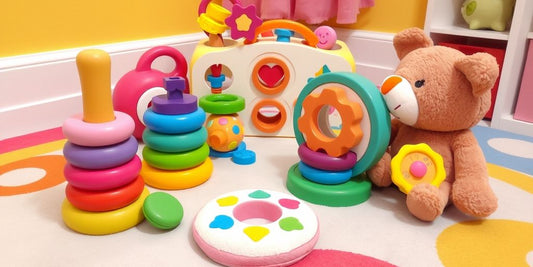Creating a balanced daily routine for your baby can feel overwhelming, but it's essential for their growth and well-being. A well-thought-out routine helps your baby feel secure and ensures they get the right mix of sleep, nutrition, and play. This guide will walk you through the steps to establish a routine that works for both you and your baby.
Key Takeaways
- Understanding your baby's needs is the first step to creating a balanced routine. Pay attention to their hunger cues, sleep signals, and developmental milestones.
- Establishing a consistent sleep schedule is crucial. Create a bedtime routine, set nap times, and be prepared to deal with sleep regressions.
- Prioritize nutrition by planning balanced meals and introducing solids at the right time. Be ready to handle any feeding challenges that come your way.
- Incorporate play and physical activity into your baby's day. Encourage tummy time, outdoor activities, and interactive play to support their development.
- Be flexible and adapt the routine to your family's unique needs. Customize the schedule, be open to changes, and handle unexpected events with ease.
Understanding Your Baby's Needs
Recognizing Hunger Cues
Babies have different ways of showing they're hungry. Recognizing these cues can help you feed them before they get too upset. Look for signs like sucking on their hands, making smacking noises, or turning their head towards your hand when you stroke their cheek.
Identifying Sleep Signals
Knowing when your baby is tired can make nap times and bedtime easier. Common sleep signals include rubbing their eyes, yawning, and becoming fussy. Understanding these signals can help you put your baby to sleep before they become overtired.
Understanding Developmental Milestones
Babies grow and change quickly. It's important to be aware of the developmental milestones they should be reaching. This includes things like smiling, rolling over, and eventually sitting up and crawling. Keeping track of these milestones can help you ensure your baby is developing normally.
Babies have unique ways of communicating their needs. By paying close attention, you can better understand and respond to what they need, whether it's food, sleep, or playtime.
Establishing a Consistent Sleep Schedule
Creating a consistent sleep schedule for your baby can make life easier for both of you. Here are some tips to help you get started.
Creating a Bedtime Routine
Babies don't have regular sleep cycles until around 6 months old. However, you can start developing a bedtime routine early on. A simple routine might include a warm bath, pajamas, a feeding, and then lights-out. This helps your baby learn to expect sleep after these activities.
Setting Nap Times
Consider starting your day by about 8:00 am. Offer daytime feedings every 2-3 hours, according to hunger cues. Pay attention to your baby's natural rhythms and try to set nap times that align with them. This can help your baby get the rest they need during the day.
Dealing with Sleep Regressions
Babies often experience sleep regressions during growth spurts or when they are learning new skills. During these times, your baby might wake up more often at night or have trouble napping. Be patient and try to stick to your routine as much as possible. Your baby will likely return to their usual sleep patterns soon.
Remember, getting into a regular schedule for sleep, feeding, and activities can make life easier for you and your baby. But how to start?
By following these tips, you can help your baby develop healthy sleep habits that will benefit them as they grow.
Prioritizing Nutrition and Meal Times

Planning Balanced Meals
Ensuring your baby gets the right nutrients is crucial for their growth. Balanced meals should include a mix of proteins, fruits, vegetables, and grains. As your baby grows, you can introduce more variety into their diet.
Introducing Solids
When your baby is ready, start with one solid meal a day. Gradually increase to two, then three meals as they grow, adding snacks in between. This gradual introduction helps them adjust to new textures and flavors.
Handling Feeding Challenges
Feeding your baby can sometimes be tricky. Babies might eat every 3-4 hours, but this can vary. If your baby is fussy or refuses to eat, try to stay calm and patient. Sometimes, changing the feeding environment or trying new foods can help.
Incorporating Play and Physical Activity
Encouraging Tummy Time
Tummy time is essential for your baby's physical development. It helps strengthen their neck, shoulders, and arm muscles. Start with short sessions and gradually increase the duration as your baby gets more comfortable. Aim for at least 20 minutes of tummy time each day. You can make it fun by placing toys within their reach to encourage grabbing and moving.
Outdoor Activities
Taking your baby outside provides fresh air and a change of scenery, which can be very stimulating. Simple activities like a walk in the stroller or a visit to the park can be very beneficial. Outdoor play helps in the development of motor skills and offers ample opportunities for physical activity. Remember to dress your baby appropriately for the weather.
Interactive Play Ideas
Interactive play is crucial for your baby's cognitive and emotional development. Activities like peek-a-boo, singing songs, and using interactive toys can be very engaging. Consider using smart vocab cards designed for interactive learning to enhance your baby's vocabulary and cognitive skills. These cards often come with engaging video tutorials that make learning fun.
Playtime is not just about fun; it's a vital part of your baby's growth and development. Incorporate a variety of activities to keep it interesting and beneficial.
Balancing Learning and Socialization

Reading and Story Time
Reading to your baby is a wonderful way to bond and introduce them to language. Daily story time can help develop their listening skills and imagination. Choose books with colorful pictures and simple words to keep them engaged. Make it interactive by pointing out objects and asking questions.
Attending Playgroups
Playgroups offer a great opportunity for your baby to interact with other children. This helps them develop social skills and learn to share. Look for local playgroups that match your schedule and your baby's age. Remember, the goal is to have fun and let your baby explore new environments.
Interactive Learning Activities
Incorporate learning into playtime with activities that stimulate your baby's mind. Simple games like peek-a-boo or stacking blocks can be both fun and educational. Rotate toys to keep things interesting and encourage different types of play. This approach supports the holistic development of your child, covering physical, emotional, and intellectual growth.
Adapting to Your Family's Unique Needs
Customizing the Routine
Every family is different, and what works for one might not work for another. Tailor your baby's routine to fit your family's lifestyle and needs. Consider your work schedules, other children's activities, and any other commitments. This way, you can create a routine that is practical and sustainable for everyone.
Being Flexible
No matter how well you plan, unexpected events will happen. Embrace flexibility and be ready to adjust the routine as needed. If your baby is having a tough day or if something comes up, it's okay to deviate from the plan. Managing your expectations and going with the flow can reduce stress and keep things running smoothly.
Handling Unexpected Changes
Life is full of surprises, and sometimes you'll need to adapt quickly. Whether it's an illness, a family emergency, or a sudden change in plans, being prepared to handle these changes is crucial. Have a few backup plans in place so you can easily switch gears when needed. Remember, it's all about finding what works best for your family and being open to change.
Using Tools and Resources
Creating a Visual Schedule
A visual schedule can be a lifesaver for busy parents. It helps you and your baby stay on track with daily activities. You can use simple charts or apps to create a visual timetable. This makes it easier for your baby to understand what comes next, reducing anxiety and tantrums.
Utilizing Apps and Technology
In today's digital age, there are many apps designed to help parents manage their baby's routine. For example, a tool like Brightwheel can simplify the process of creating daily schedules for your program. These apps can track feeding times, nap schedules, and even diaper changes. Some apps also offer reminders and tips tailored to your baby's age and developmental stage.
Seeking Support from Experts
Don't hesitate to seek advice from professionals. Pediatricians, child psychologists, and parenting coaches can offer valuable insights. They can help you customize a routine that fits your baby's unique needs. Additionally, joining parenting groups or forums can provide support and practical tips from other parents who are going through similar experiences.
Remember, every baby is different. What works for one family might not work for another. Be patient and flexible as you find the best routine for your little one.
Wrapping Up: Crafting the Perfect Routine
Creating a balanced daily routine for your baby is all about finding what works best for your family. It's important to remember that every child is different, and what suits one may not suit another. A good routine can help your baby feel secure and happy, while also giving you some peace of mind. Be patient and flexible, and don't be afraid to make changes as needed. With love, patience, and consistency, you can build a routine that supports your baby's growth and helps your family thrive.
Frequently Asked Questions
How can I tell if my baby is hungry?
Look for signs like sucking on their hands, making sucking noises, or turning their head towards your hand when you stroke their cheek. These are common hunger cues.
What are some tips for establishing a bedtime routine?
Start with a calming activity like a bath, followed by a bedtime story. Keep the routine consistent every night to help your baby understand it’s time to sleep.
How do I introduce solid foods to my baby?
Begin with single-grain cereals or pureed vegetables and fruits. Introduce one new food at a time and wait a few days before adding another to watch for any allergic reactions.
What should I do if my baby refuses to nap?
Try to create a quiet, dark environment and stick to a regular nap schedule. If they still resist, they might not be tired yet, so try again in a little while.
How can I balance playtime and learning activities?
Incorporate learning into play by using educational toys, reading books, or playing simple games that teach colors, shapes, and numbers.
What should I do if our routine gets disrupted?
Stay flexible and try to get back on track as soon as possible. It’s okay if things don’t go perfectly; just do your best to maintain consistency.









